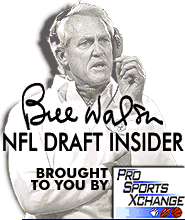
How I Evaluate Each Position:
Quarterback
By Bill Walsh
PSX Draft Insider Special
|
|
How I Evaluate Each Position: Quarterback By Bill Walsh PSX Draft Insider Special |
QUARTERBACK
Ideal size: 6-3, 210
To become a great quarterback, there must be instincts and intuition. This is the area that can be the difference between a very solid quarterback and a great quarterback. This isn't an area you can do much with as a coach. You can certainly bring a quarterback up to a competitive standard, but to reach greatness the quarterback must possess that inherently, ala Billy Kilmer, Sonny Jurgensen, Ken Stabler and Warren Moon.
If throwing a ball were the only aspect of playing quarterback, then this would be an easy position to evaluate. However, because of the dynamic role he plays on the team, a quarterback must have physical, mental, emotional and instinctive traits that go well beyond the mere ability to pass a football.
Still, if he can't pass, he obviously won't be a good quarterback either. For now, let's assume our quarterback candidate has shown an ability to throw the ball.
Now, he must be courageous and intensely competitive. He will be the one on the field who is running the team. His teammates must believe in him or it may not matter how much physical ability he has. If he is courageous and intensely competitive, then other players will know and respect that. This will be a foundation for becoming a leader.
Naturally, he will have to perform up to certain physical standards to maintain that respect and become a leader.
Arm strength is somewhat misleading. Some players can throw 80 yards, but they aren't good passers. Good passing has to do with accuracy, timing, and throwing a ball with touch so it is catchable. This all involves understanding a system, the receivers in the system, and having great anticipation. It is a plus to be able to throw a ball on a line for 35 yards, but not if it is off target or arrives in such a way that it is difficult to catch.
Remember, the goal of passing a ball is to make sure it is caught ... by your intended receiver.
You look at how complete an inventory of throws a quarterback possesses -- from screen passes to timed short passes to medium range passes and down the field throws. This complete range. For the scout, not having a complete inventory does not eliminate the quarterback. But you are looking to evaluate in all facets and distances and types of passes in throwing the ball.
There have been quarterbacks of greatness, Hall of Fame quarterbacks, who didn't have a complete inventory of passes. But you're looking to see the potential of the quarterback in each area. You can see where the emphasis of the offense would be if he were with your team.
A quick delivery , one that is not telegraphed to help the defense, gives the quarterback an advantage when he finds his intended target. That's when it is essential to get the ball "up and gone'' with no wasted motion. Some of this can be acquired by learning proper technique. But to a certain degree, a quick release is related to a quarterback's reaction time between spotting his receiver and getting the ball "up and gone.''
Touch is important, especially in a medium range passing game. One of Joe Montana's most remarkable skills was putting the right touch on a pass so that it was easily catchable by a receiver, who often did not have to break stride.
The ability to read defenses is not something that players have learned to a high degree coming out of college. Even if they have, the pro defenses are very different. But most systems require quarterbacks to look at primary and secondary receivers, usually based on the defense that confronts him. You can see if he locates that secondary receiver -- or maybe even an emergency outlet receiver -- with ease or with a sense of urgency.
This should work like a natural progression, not a situation where it's -- "Oh, my gosh, now I must look over here ... no, over there.'' You can see which quarterbacks handle these situations with grace. These are the types who have a chance to perform with consistency in the NFL.
Mobility and an ability to avoid a pass rush are crucial. Some quarterbacks use this mobility within the pocket just enough so they are able to move and pass when they "feel" a rush. But overall quickness and agility can make a remarkable difference. As an example, there were some very quick boxers in Sugar Ray Leonard's era, but he was quicker than they were and because of that he became a great champ.
Quarterbacks must be able to function while injured. The pro season is about twice as long and more punishing than a college season. They are vulnerable to getting hit hard every time they pass. They must be able to avoid being rattled, get up and show they are in control and can continue to lead the offense.
The single trait that separates great quarterbacks from good quarterbacks is the ability to make the great, spontaneous decision, especially at a crucial time. The clock is running down and your team is five points behind. The play that was called has broken down and 22 players are moving in almost unpredictable directions all over the field.
This is where the great quarterback uses his experience, vision, mobility and what we will call spontaneous genius. He makes something good happen. This, of course, is what we saw in Joe Montana when he pulled out those dramatic victories for Notre Dame.